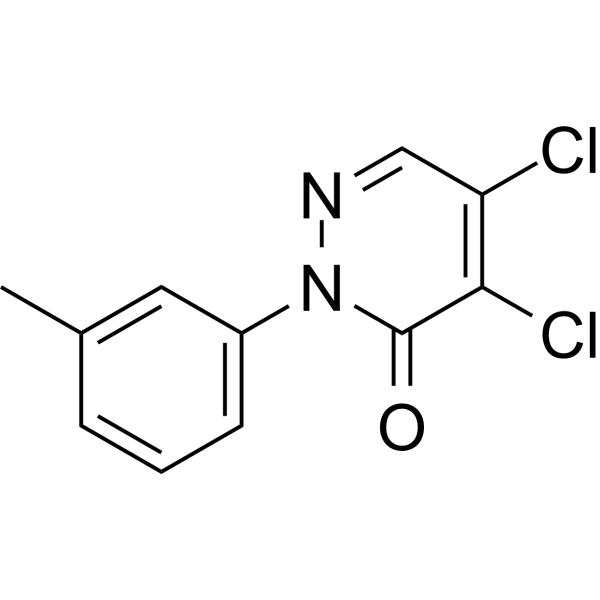Physicochemical Properties
| Molecular Formula | C11H8CL2N2O |
| Molecular Weight | 255.10 |
| Exact Mass | 254.001 |
| CAS # | 41931-13-9 |
| PubChem CID | 779573 |
| Appearance | Light yellow to light brown solid powder |
| Density | 1.39g/cm3 |
| Boiling Point | 339.6ºC at 760 mmHg |
| Flash Point | 159.2ºC |
| Index of Refraction | 1.627 |
| LogP | 2.847 |
| Hydrogen Bond Donor Count | 0 |
| Hydrogen Bond Acceptor Count | 2 |
| Rotatable Bond Count | 1 |
| Heavy Atom Count | 16 |
| Complexity | 365 |
| Defined Atom Stereocenter Count | 0 |
| InChi Key | SYUPLLHVMCLXEM-UHFFFAOYSA-N |
| InChi Code | InChI=1S/C11H8Cl2N2O/c1-7-3-2-4-8(5-7)15-11(16)10(13)9(12)6-14-15/h2-6H,1H3 |
| Chemical Name | 4,5-dichloro-2-(3-methylphenyl)pyridazin-3-one |
| HS Tariff Code | 2934.99.9001 |
| Storage |
Powder-20°C 3 years 4°C 2 years In solvent -80°C 6 months -20°C 1 month |
| Shipping Condition | Room temperature (This product is stable at ambient temperature for a few days during ordinary shipping and time spent in Customs) |
Biological Activity
| Targets | SOD1 1.07 μM (IC50) |
| ln Vitro | HCT116 cells that express the bloom syndrome gene product (BLM) or lack it are specifically cytotoxic to LCS-1 (1–10,000 nM; 24 hours) [1]. LCS-1 targets normal human bronchial epithelial (NHBE) cells (IC 50=2.66 μM) and 10/27 adenocarcinoma cell lines (median IC50=0.20 μM; such as H23, H2347, and HCC827 cell lines) [2]. In multiple myeloma (MM) cells, LCS-1 (0, 1.25, 2 μM; 4 hours) significantly inhibits SOD1 enzymatic activity in a concentration-dependent manner [3]. The viability of other MM cell lines, such as MM.1R (dexamethasone-resistant), Dox40 (doxorubicin-resistant), or LR5 (melphalan-resistant), is reduced in a dose-dependent manner by LCS-1 (0, 1.25, 2.5, and 5 μM; 48 hours) [3]. LCS-1 (48 hours) had an IC50 value of 2.5 and 4.6 μM, respectively, on the viability of ANBL6-WT (bortezomib-sensitive) and ANBL6-BR (bortezomib-resistant) cells [3]. In MM.1S cells, LCS-1 (1.25 μM; 16 h) dramatically raised ROS and O2 levels [3]. In MM.1S cells, LCS-1 (1.25 μM; 16 hours) significantly reduced the GSH/GSSG ratio [3]. In MM.1S cells, LCS-1 (1.25 μM; 24 hours) enriches proteins that mediate mtUPR signaling (HSP60/CLPP) and stimulates the release of mitochondrial cytochrome-c into the cytosol [3]. RP2CP is activated by LCS-1-induced O2 (1.25 μM; 5 hours), and RP dramatically lowers the CP form of the 126S proteasome [3]. MM.1S cells undergo both early and late apoptosis when exposed to LCS-1 (2 μM; 16 hours) [3]. In MM.1S cells, LCS-1 (0, 0.5, 1, 1.5, or 2 μM) downregulates MCL-1, BclxL, or c-Myc and upregulates p53/p21 signaling [3]. When applied to mitochondrial unfolded protein response (UPR) proteins (BIP, PERK, phosphorylated eIF2α, or lectin proteins) in MM.1S and ANBL6-BR cells, LCS-1 (0, 4, 8, 16, 24 hours; 2 μM) demonstrates a strong and quick induction [3]. |
| ln Vivo | In mice harboring MM.1S, LCS-1 (20 mg/kg; intraperitoneally given every other day for 14 days) suppresses MM growth and prolongs host survival [3]. |
| Cell Assay |
Cell Viability Assay[1] Cell Types: BLM-proficient and BLM-deficient HCT116 cells Tested Concentrations: 1-10000 nM Incubation Duration: 24 hrs (hours) Experimental Results: Had IC50 values of 1462 nM and 24.92 nM for the viability of BLM-proficient and BLM-deficient HCT116 cells, respectively. Western Blot Analysis[3] Cell Types: MM.1S and ANBL6-BR cells Tested Concentrations: 2 μM Incubation Duration: 16 hrs (hours) Experimental Results: diminished the expression of cell-cycle regulatory proteins (cyclin-B1, CDC25C, and CDC2). Western Blot Analysis[3] Cell Types: MM.1S cells Tested Concentrations: 0, 0.5, 1, 1.5, 2 μM Incubation Duration: Experimental Results: Upregulated p53/p21 signaling, as well as downregulated survival pathway proteins MCL-1, BclxL, or c-Myc. Western Blot Analysis[3] Cell Types: MM.1S cells Tested Concentrations: 2 μM Incubation Duration: 0, 4, 8, 16, 24 hrs (hours) Experimental Results: demonstrated a rapid and robust induction of UPR proteins (BIP, PERK, phosphorylated eIF2α, or a lectin protein calnexin). |
| Animal Protocol |
Animal/Disease Models: 5weeks old female CB17 SCID (severe combined immunodeficient) mouse (MM.1S tumors volume=100 mm3)[3] Doses: 20 mg/kg (diluted in saline) Route of Administration: intraperitoneal (ip)injections; treated on an every other day schedule for 14 days Experimental Results: Inhibited MM growth and prolongs host survival. |
| References |
[1]. Nanocarrier Composed of Magnetite Core Coated with Three Polymeric Shells Mediates LCS-1 Delivery for Synthetic Lethal Therapy of BLM-Defective Colorectal Cancer Cells. Biomacromolecules. 2018 Mar 12;19(3):803-815. [2]. Superoxide dismutase 1 (SOD1) is a target for a small molecule identified in a screen for inhibitors of the growth of lung adenocarcinoma cell lines. Proc Natl Acad Sci U S A. 2011;108(39):16375-16380. [3]. Proteomic analysis identifies mechanism(s) of overcoming bortezomib resistance via targeting ubiquitin receptor Rpn13. Leukemia. 2021 Feb;35(2):550-561. |
Solubility Data
| Solubility (In Vitro) | DMSO : 50 mg/mL (196.00 mM) |
| Solubility (In Vivo) |
Solubility in Formulation 1: ≥ 2.5 mg/mL (9.80 mM) (saturation unknown) in 10% DMSO + 90% Corn Oil (add these co-solvents sequentially from left to right, and one by one), clear solution. For example, if 1 mL of working solution is to be prepared, you can add 100 μL of 25.0 mg/mL clear DMSO stock solution to 900 μL of corn oil and mix evenly. (Please use freshly prepared in vivo formulations for optimal results.) |
| Preparing Stock Solutions | 1 mg | 5 mg | 10 mg | |
| 1 mM | 3.9200 mL | 19.6002 mL | 39.2003 mL | |
| 5 mM | 0.7840 mL | 3.9200 mL | 7.8401 mL | |
| 10 mM | 0.3920 mL | 1.9600 mL | 3.9200 mL |
